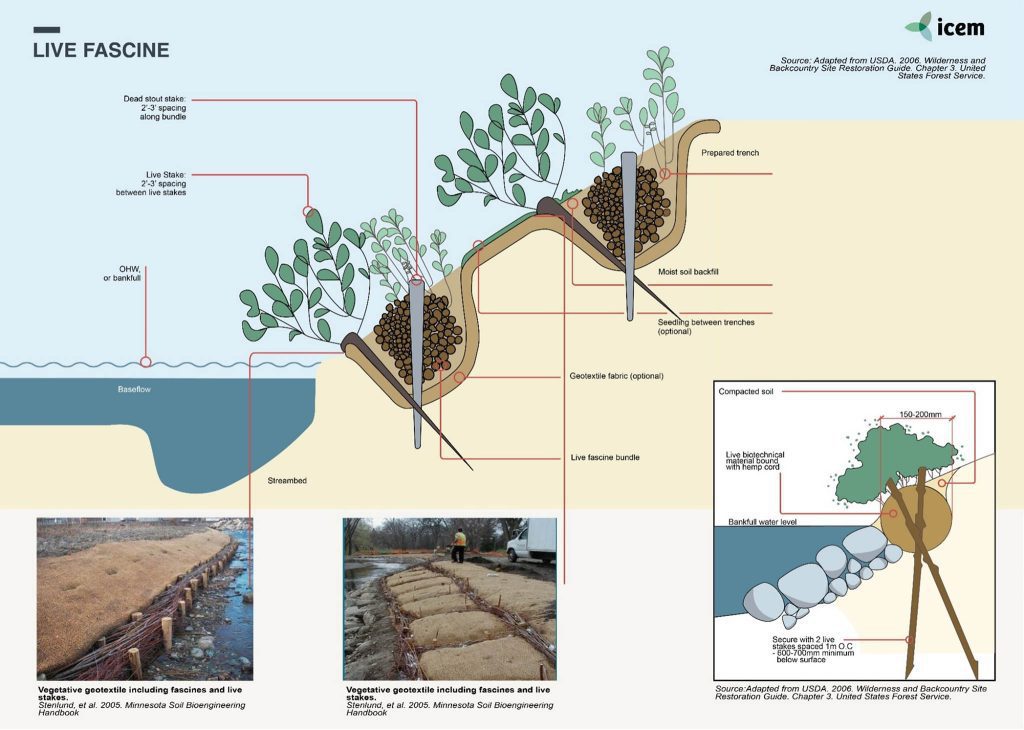| Suburban | River | Low-cost | Riverbank erosion | |
| DESCRIPTION | |
| Measures
|
Fascines are long cylindrical bundles of brushwood bound together with biodegradable fibers such as jute. They are placed in shallow trenches parallel to the direction of the river flow and are used to stabilize the river bank face or toe. The brushwood used is often willow which if live can root easily. The brushwood bundles are usually placed in a series of contour trenches along the slope of the river bank where they form a series of parallel depressions which trap sediment and organic matter including plant matter that may then also take root. This helps to stabilize the bank surface and establishes conditions for local vegetation to regenerate. |
| Location
|
Fascines are an appropriate technique for use on bank slopes where runoff is causing surface erosion. They are particularly useful in wet soil conditions where they improve drainage and are suitable for slopes where differing substrates (e.g., topsoil over sub-soil) are not well attached. They are an appropriate measure to use in cases of surface erosion but should not be used to stabilize deeper earth slips. Fascines are not suitable for rocky slopes, because the stakes and the fascines cannot be properly fixed, and vegetation cannot establish easily. |
| Design options and performance | Live fascines are an effective measure for stabilizing river banks and once properly installed provide immediate protection from surface erosion and shallow landslips. They are typically installed above full river discharge level except on streams with very small drainage areas (< 1,000 ha). When properly installed, this system does not cause much site disturbance, effectively protects slopes from shallow slides (up to 0.5m depth), and offers immediate protection from surface erosion. In one growing season the roots and shoots can grow along the entire length of the slope thus ensuring good slope stabilization. |
| Feasibility criteria
|
● Technical design: Live cuttings are usually bound together with twine at 30-45 cm spacing in bundles of 15-25 cm diameter and 2-6 m length. Each bundle should overlap slightly with the next and each bundle should contain at least five cuttings, with each cutting being a minimum of 2-4 cm in diameter. The fascine bundles are then placed end to end in trenches excavated along the contour of the bank slope and deep enough (25-40 cm) to accommodate the bundles. The spacing between the lines of fascines placed up the bank face will depend on the soil type; 1 – 1.5 m in loose soil which erodes easily and 1.5 to 2 m in more cohesive soils that are less subject to erosion. Fascine bundles are secured every meter with wedge-shaped dead stakes, or with alternating dead and live stakes, every 60-90 cm along the fascines. To encourage rooting the trenches are backfilled with loose soil, without entirely covering the live fascines.
● Soil media: n/a ● Soil slope: Depends on the type of soil but may not be stable above the 1:2 slope. ● Surface cover: n/a ● Materials: cuttings, twine, dead wedge-shaped stakes made of hardwood; live stakes. |
| Operation and maintenance | Though initially fairly labor-demanding, after installation further maintenance is usually not required but the area should be monitored, especially following any high-water events. Repairs should be made as needed and additional vegetation planted in gaps. |
| Cost and benefits | Low to medium cost measure which effectively stabilizes eroding soils on banks and also helps to remove moisture by soaking up groundwater seepage which can destabilize a slope. In addition, the developing root systems further strengthen the bank and the emerging vegetation provides a natural habitat for wildlife. |
| Design solutions | Live fascines are effective when planted along banks to reduce erosion caused by wave action or surface run-off. If installed correctly, they can offer immediate structural protection to the bank by reducing surface water velocity which makes them very useful for slopes experiencing light to moderate erosion, where individual cuttings, seedlings, or seeds would quickly wash away. At sites experiencing heavy erosion, or on steep slopes (greater than 1:2 vertical to horizontal) fascines can also be washed away particularly before the roots have established. However, if they can last for several months after planting, roots will form and stabilize the soil in the longer term, in addition to removing excess soil moisture through evapotranspiration.
● Immediately reduces surface erosion or rilling; ● Traps and holds soil on the slope face thus reducing a long slope into a series of shorter slopes; ● Within one growing season, roots and shoots grow along the entire length of the structure, quickly stabilizing the bank; ● Enhance conditions for the colonization of native vegetation by stabilizing the slope and creating a microclimate conducive to plant growth. |
| Sources | ● ICEM, 2017. Promoting Climate Resilient Rural Infrastructure in Northern Viet Nam, Technical Report 17: Technical Guidelines for Slope Protection. Prepared for the Ministry of Agriculture and Rural Development and Asian Development Bank. Hanoi.
● ICEM, 2017. Slope Protection Designs and Specifications, TA-8102 VIE: Promoting Climate Resilient Rural Infrastructure in Northern Vietnam, Technical Report No. 18. Prepared for Ministry of Agriculture and Rural Development and Asian Development Bank. Hanoi. ● United States Department of Agriculture, Natural Resources Conservation Service. 1996. Engineering Field Handbook – Chapter 16, Streambank and Shoreline Protection. ● LaRiMiT – Norwegian Geotechnical Institute (NGI). 2016. NbS for Erosion Control. ● Agro-forestry and Woodlot Extension Society. 2018. Fascines for Riparian Erosion Control. ● Terra Erosion Control Tld. 2010. Live Fascine and Brush Layer Techniques in Stream Bank Restoration. |
Originally developed under the ADB ‘TA-9417 VIE: Secondary Green Cities Development Project – Output 2: Demonstrated sustainable and resilient development in Hue, Ha Giang and Vinh Yen’. Adapted for the UN-CTCN project ‘Climate risk assessment for subnational adaptation and establishment of a local climate information system for climate change adaptation (LISA) in Cambodia’.



